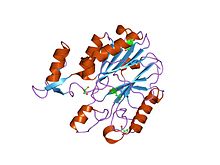
Summary
In molecular biology, multicopper oxidases are enzymes which oxidise their substrate by accepting electrons at a mononuclear copper centre and transferring them to a trinuclear copper centre; dioxygen binds to the trinuclear centre and, following the transfer of four electrons, is reduced to two molecules of water.[1] There are three spectroscopically different copper centres found in multicopper oxidases: type 1 (or blue), type 2 (or normal) and type 3 (or coupled binuclear).[2][3] Multicopper oxidases consist of 2, 3 or 6 of these homologous domains, which also share homology with the cupredoxins azurin and plastocyanin. Structurally, these domains consist of a cupredoxin-like fold, a beta-sandwich consisting of 7 strands in 2 beta-sheets, arranged in a Greek-key beta-barrel.[4]
| Multicopper oxidase (type 1) | |||||||||
|---|---|---|---|---|---|---|---|---|---|
 crystal structures of e. coli laccase cueo under different copper binding situations | |||||||||
| Identifiers | |||||||||
| Symbol | Cu-oxidase | ||||||||
| Pfam | PF00394 | ||||||||
| Pfam clan | CL0026 | ||||||||
| InterPro | IPR001117 | ||||||||
| PROSITE | PDOC00076 | ||||||||
| SCOP2 | 1aoz / SCOPe / SUPFAM | ||||||||
| Membranome | 253 | ||||||||
| |||||||||
| Multicopper oxidase (type 2) | |||||||||
|---|---|---|---|---|---|---|---|---|---|
 active laccase from trametes versicolor complexed with 2,5-xylidine | |||||||||
| Identifiers | |||||||||
| Symbol | Cu-oxidase_2 | ||||||||
| Pfam | PF07731 | ||||||||
| Pfam clan | CL0026 | ||||||||
| InterPro | IPR011706 | ||||||||
| SCOP2 | 1aoz / SCOPe / SUPFAM | ||||||||
| |||||||||
| Multicopper oxidase (type 3) | |||||||||
|---|---|---|---|---|---|---|---|---|---|
 crystal structures of e. coli laccase cueo under different copper binding situations | |||||||||
| Identifiers | |||||||||
| Symbol | Cu-oxidase_3 | ||||||||
| Pfam | PF07732 | ||||||||
| Pfam clan | CL0026 | ||||||||
| InterPro | IPR011707 | ||||||||
| SCOP2 | 1aoz / SCOPe / SUPFAM | ||||||||
| |||||||||
| CMulti-copper polyphenol oxidoreductase laccase | |||||||||
|---|---|---|---|---|---|---|---|---|---|
 crystal structure of protein cc_0490 from caulobacter crescentus, pfam duf152 | |||||||||
| Identifiers | |||||||||
| Symbol | Cu-oxidase_4 | ||||||||
| Pfam | PF02578 | ||||||||
| InterPro | IPR003730 | ||||||||
| |||||||||
The family of multicopper oxidases can be divided into three groups based on the electron-donating substrate. [5] Laccases oxidize a variety of organic substrates, metalloxidases accept metal substrates and a third group contains multicopper oxidases that are specific towards one single substrate. Multicopper oxidases include:
- Ceruloplasmin EC 1.16.3.1 (ferroxidase), a 6-domain enzyme found in the serum of mammals and birds that oxidizes different inorganic and organic substances; exhibits internal sequence homology that appears to have evolved from the triplication of a Cu-binding domain similar to that of laccase and ascorbate oxidase.
- Laccase EC 1.10.3.2 (urishiol oxidase), a 3-domain enzyme found in fungi and plants, which oxidizes different phenols and diamines. CueO is a laccase found in Escherichia coli that is involved in copper-resistance.[4]
- Ascorbate oxidase EC 1.10.3.3, a 3-domain enzyme found in higher plants.
- Nitrite reductase EC 1.7.2.1, a 2-domain enzyme containing type-1 and type-2 copper centres.[6][7]
In addition to the above enzymes there are a number of other proteins that are similar to the multi-copper oxidases in terms of structure and sequence, some of which have lost the ability to bind copper. These include: copper resistance protein A (copA) from a plasmid in Pseudomonas syringae; domain A of (non-copper binding) blood coagulation factors V (Fa V) and VIII (Fa VIII);[8] yeast Fet3p (FET3) required for ferrous iron uptake;[9] yeast hypothetical protein YFL041w; and the fission yeast homologue SpAC1F7.08.
References edit
- ^ Bento I, Martins LO, Gato Lopes G, Arménia Carrondo M, Lindley PF (November 2005). "Dioxygen reduction by multi-copper oxidases; a structural perspective". Dalton Transactions (21): 3507–13. doi:10.1039/b504806k. PMID 16234932.
- ^ Messerschmidt A, Huber R (January 1990). "The blue oxidases, ascorbate oxidase, laccase and ceruloplasmin. Modelling and structural relationships". Eur. J. Biochem. 187 (2): 341–52. doi:10.1111/j.1432-1033.1990.tb15311.x. PMID 2404764.
- ^ Ouzounis C, Sander C (February 1991). "A structure-derived sequence pattern for the detection of type I copper binding domains in distantly related proteins". FEBS Lett. 279 (1): 73–8. doi:10.1016/0014-5793(91)80254-Z. PMID 1995346. S2CID 10299194.
- ^ a b Roberts SA, Weichsel A, Grass G, Thakali K, Hazzard JT, Tollin G, Rensing C, Montfort WR (March 2002). "Crystal structure and electron transfer kinetics of CueO, a multicopper oxidase required for copper homeostasis in Escherichia coli". Proc. Natl. Acad. Sci. U.S.A. 99 (5): 2766–71. doi:10.1073/pnas.052710499. PMC 122422. PMID 11867755.
- ^ Mano, Nicolas; de Poulpiquet, Anne (2018-03-14). "O 2 Reduction in Enzymatic Biofuel Cells". Chemical Reviews. 118 (5): 2392–2468. doi:10.1021/acs.chemrev.7b00220. ISSN 0009-2665.
- ^ Nakamura K, Kawabata T, Yura K, Go N (October 2003). "Novel types of two-domain multi-copper oxidases: possible missing links in the evolution". FEBS Lett. 553 (3): 239–44. doi:10.1016/S0014-5793(03)01000-7. PMID 14572631. S2CID 85060706.
- ^ Suzuki S, Kataoka K, Yamaguchi K (October 2000). "Metal coordination and mechanism of multicopper nitrite reductase". Acc. Chem. Res. 33 (10): 728–35. doi:10.1021/ar9900257. PMID 11041837.
- ^ Mann KG, Jenny RJ, Krishnaswamy S (1988). "Cofactor proteins in the assembly and expression of blood clotting enzyme complexes". Annu. Rev. Biochem. 57: 915–56. doi:10.1146/annurev.bi.57.070188.004411. PMID 3052293.
- ^ Askwith C, Eide D, Van Ho A, Bernard PS, Li L, Davis-Kaplan S, Sipe DM, Kaplan J (January 1994). "The FET3 gene of S. cerevisiae encodes a multicopper oxidase required for ferrous iron uptake". Cell. 76 (2): 403–10. doi:10.1016/0092-8674(94)90346-8. PMID 8293473. S2CID 27473253.


